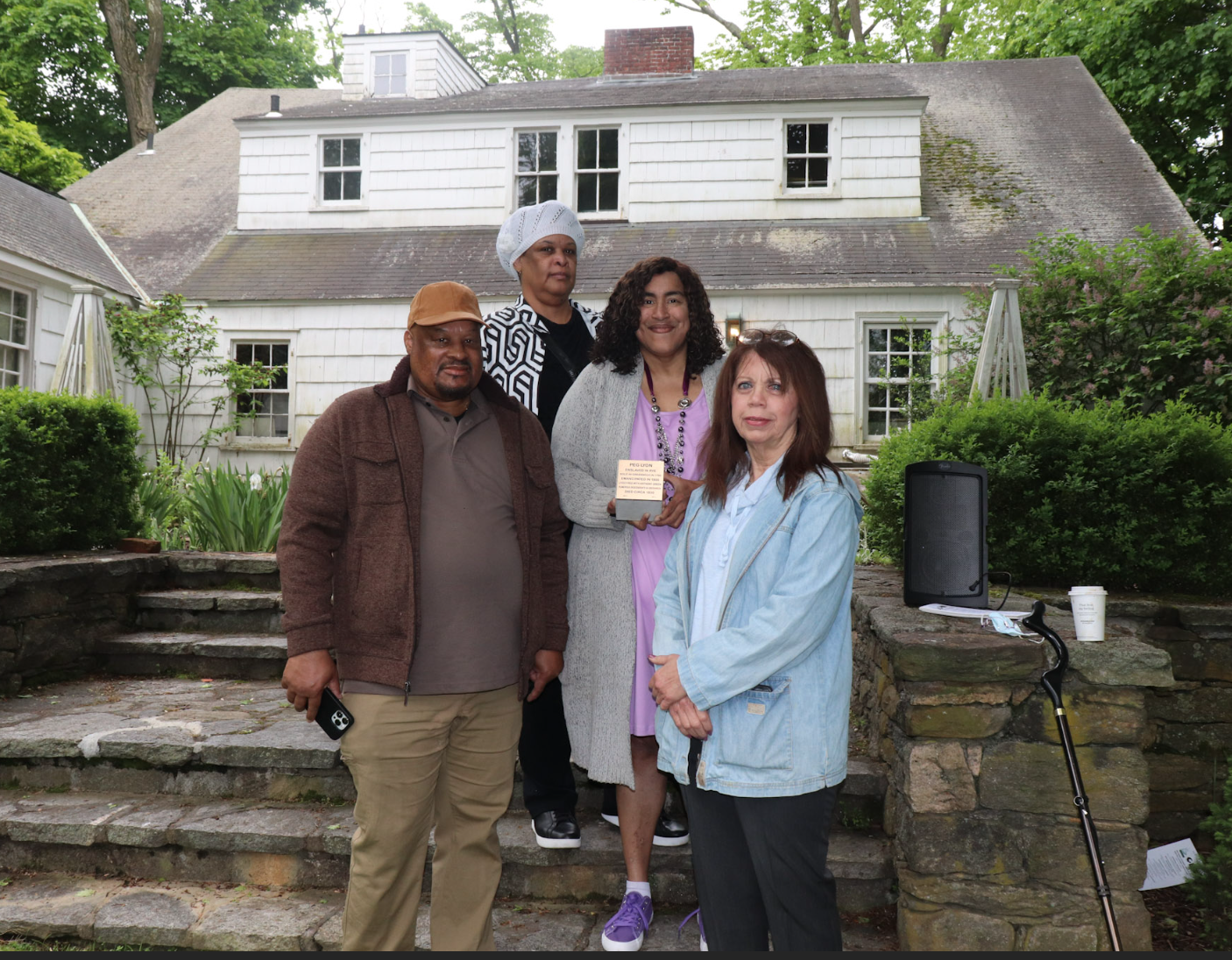
By Teresa Vega on May 17, 2024, at the Knapp House in Rye, New York
Vega delivered the following remarks at the Witness Stone installation ceremony honoring her fourth great-grandparents Peg Lyon and Anthony Green.
Today, as we gather in the spirit of kinship and remembrance, it is fitting to reflect on our rich family history. We proudly bear the name Lyon-Green-Merritt Family, paying homage to the foundational figures who shaped our collective identity. Peg Lyon Merritt Green, my fourth great-grandmother, stands as the revered matriarch of our clan, while her husband, Anthony Green, my fourth great-grandfather, assumes the honored role of patriarch. In our familial narrative, we do not delineate between them; they are inseparable, their legacies intertwined.
As descendants, we carry forward the legacy of resilience and perseverance embodied by those who came before us. Our roots trace back to the enslaved and formerly enslaved individuals of numerous families spanning New York, New Jersey, Connecticut, Pennsylvania, and Canada. Among these families, the Lyon, Merritt, and Green lineage, holds a special significance, their origins deeply rooted in the history of Rye, New York. Through the ages, Rye—known by various names such as Byram, Saw Pits, Port Chester, and East Port Chester—has remained a sacred ancestral homeland for our kin, a place we proudly claim as our own.
In the early 2000s, my cousin Andrea and I independently embarked on a journey to trace our Green lineage. It wasn’t until around 2008 that we joined forces, driven by a shared commitment to uncovering our familial history. Our efforts were initially impeded by the challenge of distinguishing between two individuals named George E. Green. However, through diligent research and scrutiny of historical documents, including JBM’s Chains Unbound: Slave Emancipations in the Town of Greenwich, we began to piece together the life stories of Peg and Anthony. Despite encountering gaps in the archives, our perseverance yielded invaluable insights, shedding light on the complex tapestry of our ancestors’ lives.
Moreover, we were struck by the presence of a rich oral history highlighting our Indigenous ancestry, a narrative that diverged from the historical accounts we encountered. Across multiple family lines, our ancestors were classified by various racial labels—Black, FPOC, Colored, Mulatto, Negro, and White confounding us.
In 2013, Andrea and I turned to genetic genealogy, a decision that would prove transformative. Little did we anticipate that DNA testing (i.e., autosomal, mtDNA, and Y-DNA testing) would shatter the brick walls erected by centuries of enslavement, dispossession, and genocide. In 2016, Peg and Anthony made their presence known to us, catalyzed by our discovery of the desecration of our Colored Cemetery in Greenwich. This awakening brought to light the very real issue of paper genocide, wherein our ancestors were systematically erased from official documents.
For the record, our Lyon-Green-Merritt lineage boasts Native American admixture ranging from 1% to 11%, with certain lines also exhibiting Native American mtDNA. Across our broader Ramapough :Lnape family network, this percentage escalates up to 25%. Since September 2016, Peg and Anthony have been guiding forces in our research, compelling us to rectify the erasure of their identities from history’s annals. As their descendants, we bear a moral imperative to amplify their voices and preserve their true narratives for posterity.
For the past 8 years, Peg and Anthony have facilitated connections with long-lost cousins, enriching our family tapestry with newfound kinship bonds. I would like to acknowledge the descendants of Peg and Anthony who are here today and ask them to stand. We have re-established kin ties with the families of Pat Bryant, Eddie Jones, Darrel Foster, Ana Hopkins-Ortiz, Bill Merritt, Wanda Johnson, Tamela Brown and many others. Gratitude abounds for our Lyon cousins—Chris Varner, Norm Davis, Andrew Melillo, Julie Pollack and her sisters, Pamela Nelville, Christopher Boesch, Dee Lyon—and countless others who have welcomed us into their fold.
Moreover, we honor the memory of departed cousins and in-laws—Keith Lyon, Helen Hamilton, Yvonne Chandler, Raymond and Louis Armour, Mark Bryant, Elsie Foster, and Walter Brown—whose legacies continue to inspire us. I would be remiss today if I did not acknowledge the lives of our ancestors Rose and her son Jack Purdy, Jr. who were memorialized with witness stones last year at the Knapp house. Special recognition is extended to individuals and organizations instrumental in our genealogical pursuits, including Dennis Culliton of the Witness Stones Project, Anne Gold, Pam McGuire, the Board of Trustees, and staff at the RHS. A special shout-out to Sheri Jordan, past Director of RHS, who always believed that Peg’s story was worthy of telling. Furthermore, we acknowledge Debra Melky, Christopher Shields, and the dedicated staff at the Greenwich Historical Society, Jo Conboy and members of the Greenwich Preservation Trust, and Alex Popp and members of The Friends of the Old Burying Ground at Byram Shore Road, for their unwavering support. As always, we are so happy to have worked with the teachers and students of The School of The Holy Child again this year.
Who were Peg and Anthony Green? They represent the genesis of our ancestral lineage. Their descendants, including their sons—Charles Merritt, Jack Husted, Anthony Jr., Platt, Allan (my third great-grandfather), Henry, and Solomon—stand as testaments to their enduring legacy. While the specifics of their familial composition remain elusive—e.g, we don’t know if they had any daughters or, if any other children were sold way from them—we know that Peg bore sons fathered by Nathan Merritt Jr., as confirmed by autosomal DNA testing.
Peg was tri-racial with Munsee Lenape and mixed-race, with East and West African ancestry on her maternale side and British ancestry on her paternal side. Likewise, Anthony, confirmed through Y-DNA testing of a male patrilineal descendant, possessed a multifaceted heritage comprising Munsee Lenape and mixed-race ancestry on his maternal line, Malagasy, West African, English, Dutch, and French Huguenot roots on his paternal line. Both of their ethnic admixtures serve to solidify Peg and Anthony’s place within the historical fabric of our region.
As we approach the 250th anniversary of our nation’s founding, we are reminded of Peg and Anthony’s lived experiences amid pivotal historical epochs. They bore witness to the Revolutionary War, the War of 1812, and the subsequent reconstruction of Rye and other former “Neutral Ground” towns across Long Island Sound and the Hudson River that led these towns to become maritime and industrial powerhouses once again. Make no mistake, Rye would not be Rye today nor would any of these coastal communities exist if not for the rich maritime culture that supported them. The trade to the West Indies, Europe, Central and South America and to West and East Africa, underscores the importance of enslaved/formerly enslaved labor. I n 1760, many people don’t know that the New York militia was comprised of Men of Color ( i.e., African, Indigenous, Afro-Indigenous and Mixed-Race). Yet, Peg and Anthony’s journey was fraught with challenges, as the promise of freedom often yielded to new forms of unfreedom for themselves and their progeny.
The wrenching separation from their sons—Jack and Henry—at tender age of 3 years old serves as a poignant reminder of the human toll exacted by slavery’s grasp. Peg, born circa 1770 into the bonds of slavery, endured unimaginable hardships, including the scourge of sexual violence—a harrowing reality for many enslaved women of her time. Her almost 6 decades of service— for three generations— within the Lyon household, laboring tirelessly in various capacities. The fact that Lavinia Lyon Brooks, Daniel Lyon’s daughter, made a survival strategy decision to leave her son John Brooks tethered to Peg, who was his wet nurse during the War of 1812, speaks volumes of the family ties that bound these women together in perilous times and underscores the resilience and fortitude that defined Peg’s existence.
Anthony’s life, marked by toil and resilience, reflects the nature of Northern slavery. Engaged in diverse occupations—from agriculture to carpentry, from maritime ventures to port labor—Anthony’s journey epitomizes the myriad challenges faced by free Black individuals in antebellum America. His decision to flee, evidenced by the harrowing account of his toe being severed, demonstrates clearly the lengths to which individuals would go to assert their autonomy.
The lives of Peg and Anthony serve as reminders of the resilience forged in the crucible of oppression. Today, as their descendants, we pay homage to their enduring legacy by commemorating them with a witness stone—a tangible testament to their indomitable spirit.
Born into bondage, Peg and Anthony embarked on a journey fraught with hardship and adversity. Yet, they refused to be defined by the shackles of enslavement, steadfastly navigating the arduous path to emancipation. Theirs was a journey marked by tenacity and courage, paving the way for future generations to transcend the limitations imposed upon them.
With each stride towards freedom, Peg and Anthony paved the way for their descendants to follow suit. From the humble beginnings of crawling to the triumphant strides of walking and running, they imbued us with the resilience to soar to greater heights. Their unwavering resolve ensured that the chains of enslavement, genocide, and dispossession could never sever our collective identity.
Today, as we stand here at the Knapp House, we honor Peg and Anthony for beckoning us to reclaim our ancestral narratives. Their voices echo through the annals of history, guiding us with a newfound mandate—to write our ancestors and their communities back into the historical record, both here and in Canada, ensuring that they are erased from memory no more.
In gratitude and reverence, we extend our heartfelt thanks to Peg and Anthony. Their legacy propels us forward on the battlefield of remembrance, armed with the conviction to honor their sacrifices and preserve their rightful place in history. Thank you.



